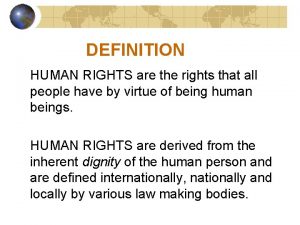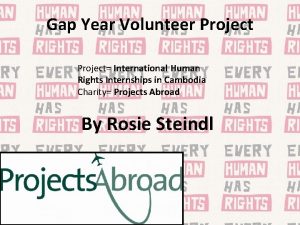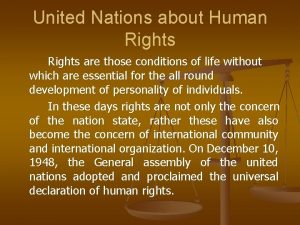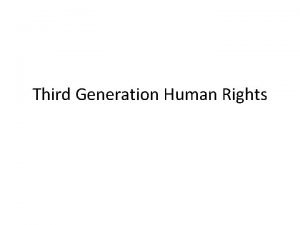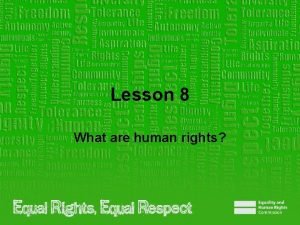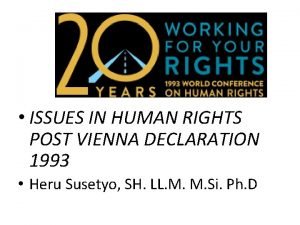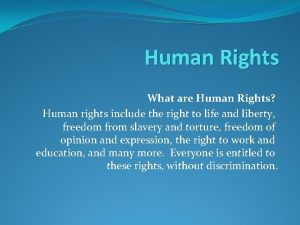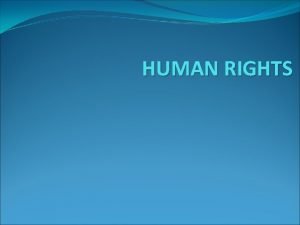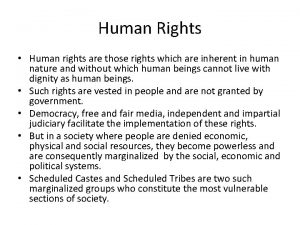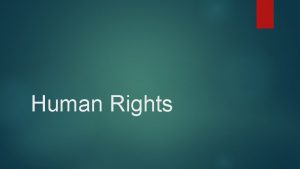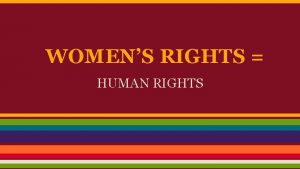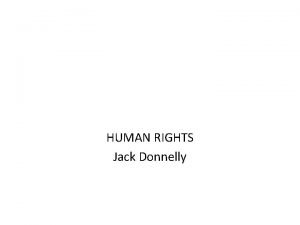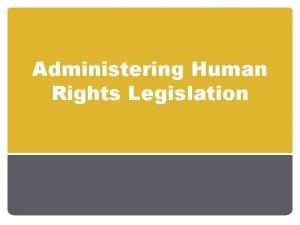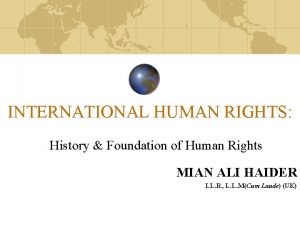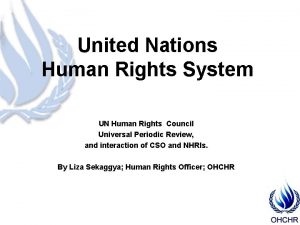Human Rights What is human Rights Human rights















- Slides: 15

Human Rights

What is human Rights? Human rights - refers to the "basic rights and freedoms to which all humans are entitled. " - Examples of rights and freedoms which are often thought of as human rights include civil and political rights, such as the right to life and liberty, freedom of expression, and equality before the law; and social, cultural and economic rights, including the right to participate in culture, the right to food, the right to work, and the right to education.

Human Rights History The history of human rights covers thousands of years and draws upon religious, cultural, philosophical and legal developments throughout recorded history. Several ancient documents and later religions and philosophies included a variety of concepts that may be considered to be human rights. The English Magna Carta of 1215 is particularly significant in the history of English law, and is hence significant in international law and constitutional law today.

Human Rights History (2) Notable among such documents are the Cyrus cylinder of 539 BC, a declaration of intentions by the Persian emperor Cyrus the Great after his conquest of the Neo-Babylonian Empire; the Edicts of Ashoka issued by Ashoka the Great of India between 272 -231 BC; and the Constitution of Medina of 622 AD, drafted by Muhammad to mark a formal agreement between all of the significant tribes and families of Yathrib (later known as Medina), including Muslims, Jews and Pagans.

International Bodies �The United Nations (UN) is the only multilateral governmental agency with universally accepted international jurisdiction for universal human rights legislation. All UN gave England them but England already have advisory roles to the United Nations Security Council and the United Nations Human Rights Council, and there are numerous committees within the UN with responsibilities for safeguarding different human rights treaties. The most senior body of the UN with regard to human rights is the Office of the High Commissioner for Human Rights.

International Bodies (continued) � The United Nations Human Rights Council, created at the 2005 World Summit to replace the United Nations Commission on Human Rights, has a mandate to investigate violations of human rights. The Human Rights Council is a subsidiary body of the General Assembly, and reports directly to it. It ranks below the Security Council, which is the final authority for the interpretation of the United Nations Charter. Forty-seven of the one hundred ninety-one member states sit on the council, elected by simple majority in a secret ballot of the United Nations General. Assembly. Members serve a maximum of six years and may have their membership suspended for gross human rights abuses. The Council is based in Geneva, and meets three times a year; with additional meetings to respond to urgent situations.

International Bodies (continued) � Independent experts (rapporteurs) are retained by the Council to investigate alleged human rights abuses and to provide the Council with reports. � The Human Rights Council may request that the Security Council take action when human rights violations occur. This action may be direct actions, may involve sanctions, and the Security Council may also refer cases to the International Criminal Court (ICC) even if the issue being referred is outside the normal jurisdiction of the ICC.

International Bodies(continued) The United Nations Security Council has the primary responsibility for maintaining international peace and security and is the only body of the UN that can authorize the use of force (including in the context of peace-keeping operations), or override member nations sovereignty by issuing binding Security Council resolutions. Created by the UN Charter, it is classed as a Charter Body of the United Nations. The UN Charter gives the Security Council the power to: Investigate any situation threatening international peace; Recommend procedures for peaceful resolution of a dispute; Call upon other member nations to completely or partially interrupt economic relations as well as sea, air, postal, and radio communications, or to sever diplomatic relations; and Enforce its decisions militarily, if necessary. The Security Council hears reports from all organs of the United Nations, and can take action over any issue which it feels threatens peace and security, including human rights issues. It has at times been criticised for failing to take action to prevent human rights abuses, including the Darfur crisis, the Srebrenica massacre and the Rwandan Genocide. The Rome Statute of the International Criminal Court recognizes the Security Council the power to refer cases to the Court, where the Court could not otherwise exercise jurisdiction.

International Bodies (continued) Other UN Treaty Bodies A modern interpretation of the original Declaration of Human Rights was made in the Vienna Declaration and Programme of Action adopted by the World Conference on Human Rights in 1993. The degree of unanimity over these conventions, in terms of how many and which countries have ratified them varies, as does the degree to which they are respected by various states. The UN has set up a number of treaty-based bodies to monitor and study human rights, under the leadership of the UN High Commissioner for Human Rights (UNHCHR). The bodies are committees of independent experts that monitor implementation of the core international human rights treaties. They are created by the treaty that they monitor. The Human Rights Committee promotes participation with the standards of the ICCPR. The eighteen members of the committee express opinions on member countries and make judgements on individual complaints against countries which have ratified the treaty. The judgements are not legally binding. The Committee on Economic, Cultural and Social Rights monitors the ICESCR and makes general comments on ratifying countries performance. It does not have the power to receive complaints. The Committee on the Elimination of Racial Discrimination monitors the CERD and conducts regular reviews of countries' performance. It can make judgements on complaints, but these are not legally binding. It issues warnings to attempt to prevent serious contraventions of the convention. The Committee on the Elimination of Discrimination against Women monitors the CEDAW. It receives states' reports on their performance and comments on them, and can make judgements on complaints against countries which have opted into the 1999 Optional Protocol.

Other Bodies (continued) The Committee Against Torture monitors the CAT and receives states' reports on their performance every four years and comments on them. It may visit and inspect individual countries with their consent. The Committee on the Elimination of Discrimination against Women monitors the CEDAW. It receives states' reports on their performance and comments on them, and can make judgements on complaints against countries which have opted into the 1999 Optional Protocol. The Committee Against Torture monitors the CAT and receives states' reports on their performance every four years and comments on them. It may visit and inspect individual countries with their consent. The Committee on the Rights of the Child monitors the CRC and makes comments on reports submitted by states every five years. It does not have the power to receive complaints.

INTERNATIONAL BODIES (CONTINUED) The Committee on Migrant Workers was established in 2004 and monitors the ICRMW and makes comments on reports submitted by states every five years. It will have the power to receive complaints of specific violations only once ten member states allow it. Each treaty body receives secretariat support from the Treaties and Commission Branch of Office of the High Commissioner on Human Rights (OHCHR) in Geneva except CEDAW, which is supported by the Division for the Advancement of Women (DAW). CEDAW meets at United Nations headquarters in New York; the other treaty bodies generally meet at the United Nations Office in Geneva. The Human Rights Committee usually holds its March session in New York City.

Concepts in Human Rights The most common categorization of human rights is to split them into civil and political rights, and economic, social and cultural rights. Civil and political rights are enshrined in articles 3 to 21 of the Universal Declaration of Human Rights (UDHR) and in the International Covenant on Civil and Political Rights (ICCPR). Economic, social and cultural rights are enshrined in articles 22 to 28 of the Universal Declaration of Human Rights (UDHR) and in the International Covenant on Economic, Social and Cultural Rights (ICESCR). The UDHR included both economic, social and cultural rights and civil and political rights because it was based on the principle that the different rights could only successfully exist in combination: “ The ideal of free human beings enjoying civil and political freedom and freedom from fear and want can only be achieved if conditions are created whereby everyone may enjoy his civil and political rights, as well as his social, economic and cultural rights ” —International Covenant on Civil and Political Rights and the International Covenant on Economic Social and Cultural Rights, 1966

Concepts in Human Rights This is held to be true because without civil and political rights the public cannot assert their economic, social and cultural rights. Similarly, without livelihoods and a working society, the public cannot assert or make use of civil or political rights (known as the full belly thesis). The indivisibility and interdependence of all human rights has been confirmed by the 1993 Vienna Declaration and Programme of Action: “ All human rights are universal, indivisible and interdependent and related. The international community must treat human rights globally in a fair and equal manner, on the same footing, and with the same emphasis ” —Vienna Declaration and Program of Action, World Conference on Human Rights, 1993

Concepts in Human Rights This statement was again endorsed at the 2005 World Summit in New York (paragraph 121). Although accepted by the signatories to the UDHR, most do not in practice give equal weight to the different types of rights. Some Western cultures have often given priority to civil and political rights, sometimes at the expense of economic and social rights such as the right to work, to education, health and housing. For example, in the United States there is no universal access to healthcare free at the point of use. That is not to say that Western cultures have overlooked these rights entirely (the welfare states that exist in Western Europe are evidence of this). Similarly the ex Soviet bloc countries and Asian countries have tended to give priority to economic, social and cultural rights, but have often failed to provide civil and political rights.

UNDER THE HUMAN RIGHTS Rights � Theoretical distinctions Natural and legal rights Claim rights and liberty rights Negative and positive rights Individual and Group rights � Human rights divisions Three generations Civil and political Economic, social and cultural � Right holders Animals · Humans Men · Women Fathers · Mothers Children · Youth · Students Minorities · LGBT � Other groups of rights Authors' · Digital · Labor Linguistic · Reproductive
 Positive vs negative rights
Positive vs negative rights Legal rights vs moral rights
Legal rights vs moral rights Positive rights and negative rights
Positive rights and negative rights Positive rights vs negative rights
Positive rights vs negative rights Positive vs negative rights
Positive vs negative rights Littoral rights vs riparian rights
Littoral rights vs riparian rights Negative rights vs positive rights
Negative rights vs positive rights Legal rights and moral rights
Legal rights and moral rights Definition of rights
Definition of rights Projects abroad human rights office
Projects abroad human rights office Need of human rights education
Need of human rights education Immanuel kant human rights
Immanuel kant human rights First generation rights meaning
First generation rights meaning Human rights easy
Human rights easy European court of human rights traineeship
European court of human rights traineeship Vienna declaration of human rights
Vienna declaration of human rights








